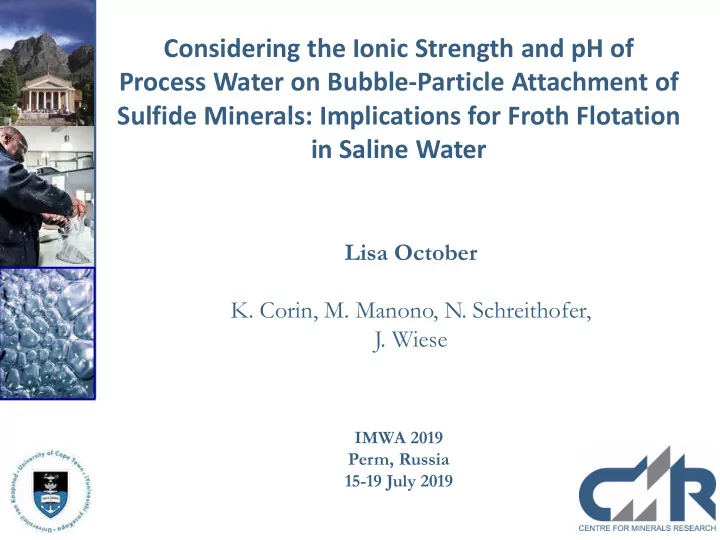

Considering the Ionic Strength and pH of Process Water on Bubble-Particle Attachment of Sulfide Minerals: Implications for Froth Flotation in Saline Water Lisa October K. Corin, M. Manono, N. Schreithofer, J. Wiese IMWA 2019 Perm, Russia 15-19 July 2019
Background Creating the hydrophobic mineral surface The formation of bubbles with a fixed size and distribution The collision between the mineral and bubble and potential attachment Transport of the bubble-particle aggregate through the pulp phase Transfer of the bubble-particle aggregate to the froth phase Collection of the bubble-particle aggregate from the froth phase Wills and Finch (2015) 2
Background NEED TO RECYCLE & RECIRCULATE WATER WITHIN MINING OPERATIONS Pulp Phase = 80 – 85 % Water (Muzenda, 2010) - CO 3 Ca 2+ 2- Mg 2+ SO 4 2- Mg 2+ SO 4 Na + Cl - Ca 2+ Na + Wills and Finch (2015) 3
Bubble-Particle Attachment Thinning of wetting film to 1 critical thickness. Wetting film becomes unstable and ruptures leading 2 formation of 3 phase contact line and the attachment of particle to bubble. The bubble-particle contact line spreading 3 across surface = stable wetting perimeter. From Albijanic et al . (2010) 4
Factors Affecting B-P Attachment • Particle Size • Particle Shape Particle Characteristics • Surface Liberation of Value • Bubble Size Bubble Characteristics • Gas Type • Temperature • pH Pulp Chemistry • Electrolytes/Ions • Reagents 5
Fundamental Bubble-Particle Attachment Measuring this Parameter
History of Attachment Timers Yoon and Sven- Eigeles and Yordan (1991) Glembotsky Nilsson Volova Gu et al . (2003) (1953) (1934) (1960) Albijanic et al . (2015) 7
A New Attachment Timer Needles Shovel Collection Bin Pool with Particle Bed and Water Camera 8
Effect of Electrolytes on B-P Attachment KCl-Quartz Bitumen What happens in a complex water system? 9 From Yoon and Yordan (1991), Gu et al. (2003)
Effect of IS and pH Recovery ↑ with ↑ IS, ↓Recovery with ↑ pH At pH 11: Recovery ↑ with ↑ IS 250 200 Solids recovery, g 150 100 Recovery ↑ with ↑ IS, 50 ↓Recovery with ↑ pH 0 0 100 500 0 100 500 0 100 500 0 100 500 0 100 500 0 100 500 g/t g/t g/t g/t g/t g/t 1SPW 5SPW 10 SPW 1SPW 5SPW 10 SPW pH 9 pH 11 Solids Recovered (g) 10 From Tadie et al. (2016), Manono et al. (2017)
Key Question But How Does an Increase in both Ionic Strength and pH of Process Water Affect the Fundamental Bubble- Particle Attachment Process? ? 11
Experimental Programme pH Modifiers: NaOH/HCl Collector: SIBX Synthetic Galena (PbS) Plant 1 SPW 5 SPW 10 SPW Waters Chalcopyrite (Cu 2 S) Ca 2+ Mg 2+ Na + Cl - 2- - 2- SO 4 NO 3 CO 3 TDS Ionic Water ppm ppm ppm ppm ppm ppm ppm mg/L Strength type mol/L 80 70 153 287 240 176 17 1023 0.0213 1SPW 5 SPW 400 350 765 1435 1200 880 85 5115 0.0977 10 SPW 800 700 1530 2870 2400 1760 170 10230 0.1860 12 7
Attachment Probability: Galena 50 45 Attachment Probabilty (%) 40 35 30 25 ↑ pH = ↓ Attachment 20 Probability 15 10 5 0 1 SPW 5 SPW 10 SPW Natural pH 45.7 44.4 41.0 pH 11 9.09 3.54 5.05 12 ↑ pH = ↓ Mass 10 Mass Recovered (mg) Recovered; 8 ↑ IS = ↑ Mass 6 Recovered 4 2 0 1 SPW 5 SPW 10 SPW Natural pH 0.85 4.2 9.95 13 pH 11 0.85 1.25 2.5
Fundamental B-P Attachment Vs Classical Microflotation Nyabeze and McFadzean, 2016 14
Fundamental B-P Attachment Vs Classical Microflotation Nyabeze and McFadzean, 2016 15
Microflotation: Galena 100 90 80 70 Galena Recovery (%) 60 50 40 30 20 10 0 0 5 10 15 20 25 Time (mins) 1 SPW_pH11 5 SPW_pH11 10 SPW_pH11 1 SPW 5 SPW 10 SPW 16
Attachment Probability: Chalcopyrite 100.0 90.0 Attachment Probability (%) 80.0 70.0 60.0 ↑ pH = ↓ Attachment 50.0 40.0 Probability 30.0 ↑ IS = ↑ Attachment 20.0 Probability 10.0 0.0 1 SPW 5 SPW 10 SPW Natural pH 69.6 85.2 90.4 pH 11 2.02 4.67 11.87 8 ↑ pH = ↓ Mass Mass Recovered (mg) 7 Recovered 6 ↑ IS = ↑Mass 5 Recovered 4 3 2 1 0 1 SPW 5 SPW 10 SPW Natural pH 2.35 2.7 6.5 pH 11 0.45 1.9 2.75 17
Microflotation: Chalcopyrite 100 90 80 CHALCOPYRITE RECOVERY (%) 70 60 50 40 30 20 10 0 0 5 10 15 20 25 TIME (MINS) 1 SPW 5 SPW 10 SPW 1 SPW_pH11 5 SPW_pH11 10 SPW_pH11 18
Zeta Potential 15 Potential difference across phase 10 boundaries between solids & liquids. 5 Zeta Potential (mV) Measure of electric charge on particles 0 0 2 4 6 8 10 12 14 -5 suspended in liquid. -10 -15 -20 -25 -30 ↑ IS = ↑ Zeta Potential -35 of Galena pH pH 11 : ↑ Zeta Potential 1 SPW 5 SPW 10 SPW Ultra-Purified Water 20 10 Zeta Potential (mV) 0 ↑ IS = ↑ Zeta Potential 0 2 4 6 8 10 12 14 of Chalcopyrite -10 pH 11 : ↑ Zeta Potential -20 -30 -40 pH 19 1 SPW 5 SPW 10 SPW Ultra-Purified Water
Value of this Work Recycle/Recirculate Process Water ↑B -P Attachment: ↑ Ions In Compression of Process Water EDL ↓B -P Attachment: Combination of ↑ Hydroxo Hydroxo Complexes Varying Water complexes In Streams = pH Deposited on Process Water Change Mineral Surface Simultaneous At Elevated pH: ↑ IS Effect - Various Hydroxo Not Detrimental to Complexes Sulfide B-P Attachment 20
Acknowledgements 21 This Project has received funding from the European Union H2020 programme under grant agreement No 730480
Measuring Attachment Probability Before Attachment After Attachment 22
Recommend
More recommend